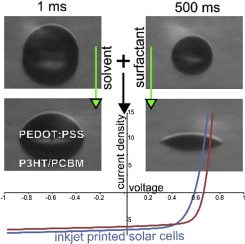Organic Electronics ( IF 2.7 ) Pub Date : 2018-06-24 , DOI: 10.1016/j.orgel.2018.06.004 Sander Kommeren , Michiel J.J. Coenen , Tamara M. Eggenhuisen , ThijsM.W.L. Slaats , Harrie Gorter , Pim Groen

|
A commonly used strategy in the fabrication of organic electronics involves the use of orthogonal solvents, i.e. the alternating use of organic solvents and water for the application of consecutive layers to prevent dissolution of previous layers. This strategy therefore requires the deposition of sequential layers with a large mismatch in surface energy. In case of organic photovoltaics (OPV) a particularly challenging deposition is that of the aqueous Poly(3,4-ethylenedioxythiophene) Polystyrene sulfonate (PEDOT:PSS) on the hydrophobic Poly(3-hexylthiophene-2,5-diyl/Phenyl-C61-butyric acid methyl ester (P3HT/PCBM) layer. The mismatch in surface energy causes dewetting and inhomogeneous layer formation. In inkjet printing individually placed droplets should spread sufficiently far to form a homogeneous closed layer before the solvents in the droplet evaporate. A formulation for the aqueous PEDOT:PSS layer has been developed in which the combination of solvents and surfactants is essential for achieving a homogenous layer on the timescales needed for inkjet printing. Homogenous layers of PEDOT:PSS on P3HT/PCBM were achieved for layer thicknesses from 400 nm to 50 nm. The efficiency of the OPV's fabricated with the new formulation were comparable with reference devices, where evaporated molybdenum oxide (MoOx) was used as a topelectrode. This shows that by the addition of solvents and surfactants a hydrophilic solution can be inkjet printed successfully to form homogenous layers on hydrophobic surfaces and achieve good efficiencies in an inverted organic solar cell.
中文翻译:

结合溶剂和表面活性剂在有机太阳能电池中的P3HT / PCBM上喷墨印刷PEDOT:PSS
有机电子制造中常用的策略涉及使用正交溶剂,即交替使用有机溶剂和水来施加连续的层,以防止先前的层溶解。因此,该策略要求沉积具有较大表面能失配的连续层。对于有机光伏(OPV),特别具有挑战性的沉积是在疏水性聚(3-己基噻吩-2,5-二基/苯基-C61)上的聚(3,4-乙撑二氧噻吩)水溶液聚苯乙烯磺酸盐(PEDOT:PSS)的沉积。 -丁酸甲酯(P3HT / PCBM)层。表面能的不匹配会引起去湿和不均匀的层形成。在喷墨印刷中,单独放置的液滴应散布足够远,以形成均匀的封闭层,然后液滴中的溶剂蒸发。对于水性PEDOT:已开发出PSS层,其中溶剂和表面活性剂的组合对于在喷墨打印所需的时间范围内获得均匀的层至关重要。实现了P3HT / PCBM上PEDOT:PSS的同质层,层厚度为400 nm至50 nm。采用新配方制造的OPV的效率可与参考设备相媲美,在参考设备中,蒸发的氧化钼(MoOx)用作顶部电极。这表明通过添加溶剂和表面活性剂,可以成功地喷墨印刷亲水性溶液,从而在疏水性表面上形成均匀的层,并在倒置的有机太阳能电池中获得良好的效率。











































 京公网安备 11010802027423号
京公网安备 11010802027423号